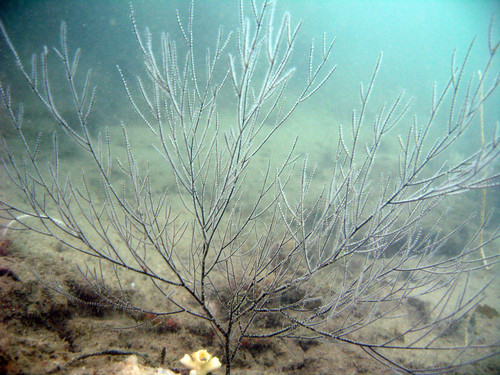Blog Log! October 28!
 October 30, 2007
October 30, 2007
The monsoon season is here but it’s still quiet down at Hantu. Just as well! The Hantu Blog left with a full boat of divers this weekend and comprised several nationalities – from the UK to US, and India to Western Europe. Of course, most of us were seasoned locals who just couldn’t wait to discover another day of diving at Hantu’s every surprising reefs!
Our first dive of the ay was relatively quiet less a few angry damsels. We encountered a pair of nonchalant Copper banded Butterflyfish which were quite happy feeding and didn’t mind being photographed. I also spotted a patch of algae growing on a coral head (second from left). There’re several factors that could lead to algae blooming, one of the most common reasons along developed coasts is the runoff of fresh water. Speaking of runoff, it was mentioned in a UN report released just this week that there has been “a rapid rise of “dead zones,” where marine life no longer can be supported because pollutants like runoff fertilizers deplete oxygen.” Luckily for us, there’s still lots of corals to be observed and the algae growth around Hantu (at least so far) seems to be in isolated patches.
Can you spot the filefish in the photo on the far left? It’s got its tail facing the camera. What’s amazing camouflage! Another critter that seeks safety amongst coral is a tiny tube worm (2nd from the right). Can you see them? They’re the tiny, salmon-coloured nodes that seem to be sticking out of the coral. They’ve got themselves embedded within this Favia boulder coral and that’s probably where they will stay for a long time, harvesting food from the current and growing deeper within the coral. On the far right, a colony of zoanthids.
As we moved along the dive, we came across two separate schools of razorfish, also called shrimpfish. They comprise four small species of tropical marine fish and can be found in the Indian and Pacific Oceans.
Razorfish are nearly transparent and flattened from side to side with long snouts and a sharp-edged belly. A thin, dark stripe runs along its body. It is from this and their shrimp-like appearance that their name is derived. They swim in a synchronized manner with their bodies pointing down.*
This is the first time I’ve photographed the Three Saddle Cardinalfish in Hantu waters. They appear less common than the other species of cardinalfishes which can be spotted amongst Hantu’s plate corals. This fish may be found in marine, brackish, and freshwater environments and is primarily marine. It is known to be nocturnal and can be commonly found in the aquarium trade.**
On the second dive, we explored the deeper depths and searched amongst the whip corals for interesting lifeforms. We found (L-R) allied cowries, crinoids, and whip shrimp.
I also came across this brilliant coral and I think it is a Black coral – the only coral in the world that has been listed as a threatened species by the United Nations. Usually you’d see them with red or orange-coloured polys. It is called Black coral because unlike most corals, its skeleton is black instead of white, as is observed when most corals die or get bleached. It became a protected species because its trade in the aquarium trade, jewelery trade and collection as a curio has severely threatened its survival throughout its range. How encouraging it is to find this in Hantu! If you dive and come across more Black corals in local waters, please email us and send us your pictures!
Slugs and flatworms are always fun to shoot underwater because they are so colourful but also because they just sort of stay still and let you have a go at them!
Finally, everyone’s favourite and a gem in Hantu’s reef – Tigertail seahorses can be spotted on a regular basis. Similar to slugs, they move slowly (infact, seahorses are the slowest fishes in the sea!) and are easily photographed. Because of that, they are also easily collected for the aquarium trade. Like Black coral, all species of seahorses are prohibited from trade because their use in traditional medicines has severely threatened their survival.
Pulau Hantu has 2 varieties of Tigertail seahorse, above is the mottled variety. But whatever colour they feature primarily, all Tigertails have the distinct striped markings at the tip of their tails that give them their name.
Stay tuned to the blog to check out our cool videos from this dive! Coming soon!




























 Posted in
Posted in 



 content rss
content rss
October 31st, 2007 at 5:33 pm
Hi Deb, I think they are two different species as I don’t remember seeing stripes on the yellow one.
The tigertailed one is for sure Tiger tail seahorse but I think the yellow one is a variety of Spotted seahorse. So we have seen at least two species at P. Hantu! Let’s see if we can find some more 😉
November 6th, 2007 at 5:36 pm
wow nice seahorse photos!
have linked to this post in my blog.
May I know who took the photos? I would love to credit him/her.
I would also like to reproduce the photos at my blog if possible. best if it has a copyright logo specifying it belongs to http://www.pulauhantu.org 🙂